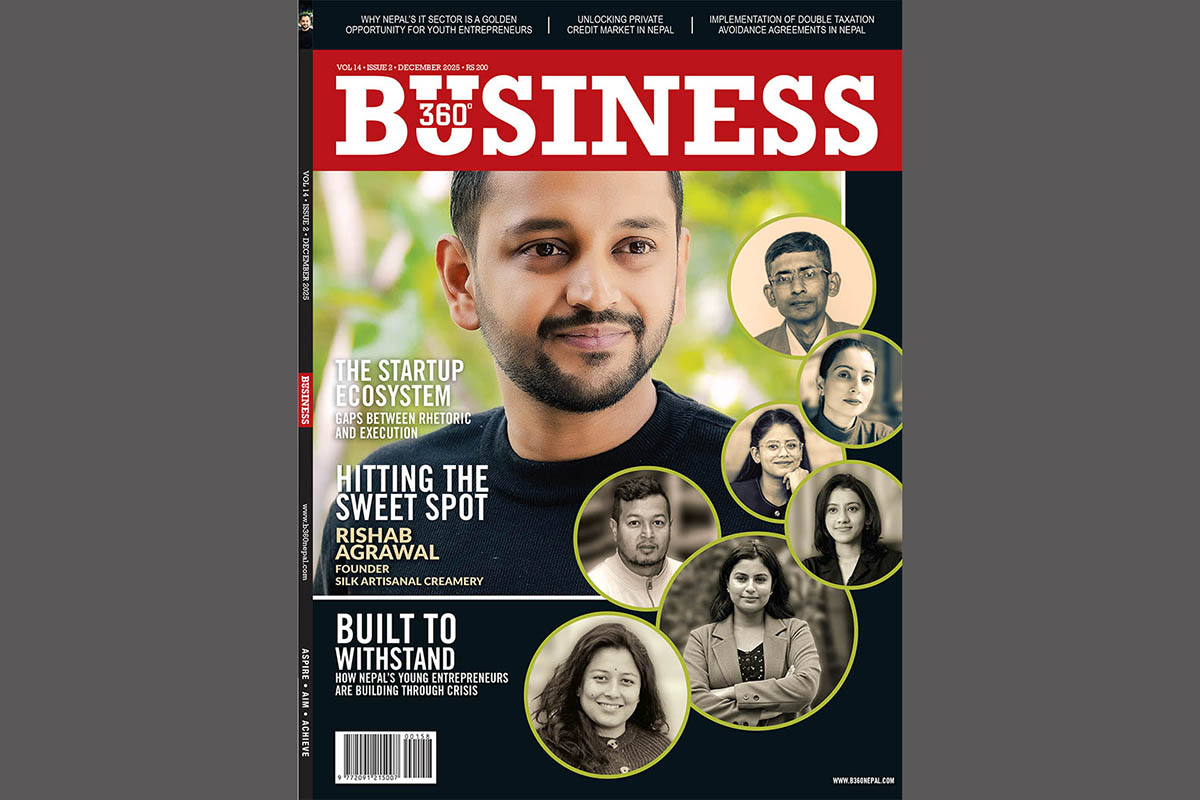
The first thing that Garima Somani, a 20-year-old undergraduate student at Kathmandu University, does when she wakes up is scroll through her Instagram feed. “It has become a habit for me to turn on my phone and automatically open up Instagram and scroll through my newsfeed. I also check if I’ve gotten any texts or emails.” she shares. Much like Somani, who first started using Facebook in 2009, this has become a reality for many of the nation’s first wave of digital natives. With internet connectivity and smartphone availability exponentially rising each year, the number of Nepalis online has been steadily growing through the last decade. Whether it’s a classroom group chat on Messenger, or the Instagram page of a local bakery, it seems that right now everyone who is online has their own specific set of uses for social media.






“As Instagram and Facebook are the fastest-growing social networking platforms, we could reach many potential customers and target audiences in a simple way. Also, it helps lower the marketing expenses for small startups like us.” Anurag Dahal Co-founder Sattava Books
How well have we assimilated Social Media?
Almost a decade back in 2011 -when Social Media was only just starting to gain traction in Nepal - UN data suggests that that there were a little more than a million internet users which accounted for barely 9% of the total national population. Fast-forward nine years and this number has drastically changed. Today, the number of internet users has sky rocketed to over 16 million, a whopping 55.6% of the total population in Nepal. Out of this 16 million, 10 million are viewed as active social media users. However unlike a decade ago, the percentage of internet penetration is not the only trend that we should be considering. Over the years, the internet and social media have far exceeded its initial purpose of simply increasing connectivity. In current times, it has become a hub for commerce, advertisement and learning. Now even more niche statistics such as engagement rates and profile visits have transitioned social media platforms to become a ground for a new wave of business and personal habits. Even within social media, users are divided not just on the basis of what their age or location is but also on who they choose to follow and how they choose to interact with other users on social media. This means that the data that builds social media also allows it to divide users into niche groups where the type of content a user sees has been tailor made to fit the preferences of the particular user. Birat Shrestha who runs Access Universe a strategic consulting firm is also a faculty of marketing and social media networking at Kathmandu University. He shares, “Media used to be something that was enjoyed as a group or a family. Now media has become an individual commodity. While television was popular because of mass viewership, social media is popular because of massive customisation.”
“Social media statistics has been key in terms of finding the right customers online, it increases traffic for us, and provides us with factual data on how many people are interested in a product.” Ritu Rajbhandari Business Development Director, Mint Studio
A new wave for businesses
With social media growing more and more diverse and yet more optimizable, it has led to digital disruption in terms of enterprises and new business environments. Jobs that were unfathomable before have become commonplace, and social media has turned into a playground for advertisers. Data from Facebook’s self-service advertising tools suggests that up until January 2020, Facebook ads could reach out to up to 9.9 million unique users in Nepal. Instagram adverts come in second place with a reach of 1.2 million users. With high trackable numbers like these paired with a cost cap that is far lower than cable TV, why wouldn’t businesses seek to capitalise on this and advertise online? It is because of this nature of social media, enterprises across the country having been scurrying to create a digital identity for themselves. Be it a telecommunications giant like Ncell or an SME that is operating at minimal budget.Almost a decade back in 2011 -when Social Media was only just starting to gain traction in Nepal - UN data suggests that that there were a little more than a million internet users which accounted for barely 9% of the total national population. Fast-forward nine years and this number has drastically changed. Today, the number of internet users has sky rocketed to over 16 million, a whopping 55.6% of the total population in Nepal. Out of this 16 million, 10 million are viewed as active social media users.As a matter of fact, this cheap efficiency that social media delivers seems to have created a unique ecosystem of small local level online businesses in Nepal where consumers with particular interests follow and support companies that they like. Take Sattava Books for instance, an online bookstore that recently started in Kathmandu, which has managed to amass over 700 hundred followers on Instagram in barely half a month of operation. Anurag Dahal, one of the co-founders of the store shares, “As Instagram and Facebook are the fastest-growing social networking platforms, we could reach many potential customers and target audiences in a simple way. Also, it helps lower the marketing expenses for small startups like us.” This seems to be the case for a lot of Nepali startups and SMEs. A jacket ad in a big daily can go for rates as high as 45 lakhs, and a minute long advert on national television for a single day could go as high as 1.3 lakhs. With such high marketing costs, small businesses have no choice but to market themselves online; and this seems to be working. Somani, who often buys clothes from local online stores says, “I don’t often read the paper and I rarely turn on the TV. Usually the stuff I buy are things that I see on posts from stores that I follow on Instagram.”

“Media used to be something that was enjoyed as a group or a family. Now media has become an individual commodity. While television was popular because of mass viewership, social media is popular because of massive customisation.” Birat Shrestha Access UniverseHowever, businesses have not gone totally online either. Some have opted to use a hybrid version of offline and online sales. Mint Studio, a local lifestyle brand, happens to sell their products both online as well as from their studio in New Road. Despite this, Ritu Rajbhandari, Business Development Director does share that a good percentage of their normal sales are from online purchases. Rajbhandari admits that social media statistics has been key in terms of finding the right customers online, sharing, “It increases traffic for us, and provides us with factual data on how many people are interested in a product.” Furthermore, Rajbhandari suggests that social media has also really helped the brand retain customers. “If it weren’t for Facebook, Instagram or TikTok, we wouldn’t have been able to track our customers. With social media there is a two-way flow of information between the customers and us,” she shares. Birat Shrestha, who over the years has had to work with many local brands, shares the same sentiment and states, “While social media does help find new clients, one of the best ways it has helped me is to reconnect or keep in touch with past clients. With social media, old clients are constantly viewing your posts and content.”
The birth of influencers
Perhaps one of the most interesting things to have come from social media is the rise of influencers; niche opinion leaders who regularly connect and engage with like-minded followers. Social media allows a lot of individuals to let loose of their creative passions and while trends like blog pages did exist before, platforms like TikTok, YouTube and Instagram really allowed for creatives to put their passions out to the world. This could mean anything from fashion models on Instagram to a vlogger documenting on YouTube. As it happens, in a survey conducted by global toy giant Lego, they concluded that kids today were more likely to aspire for a career as a vlogger in contrast to that of an astronaut.
“In urban spaces, technological literacy has allowed a place for all these social media pages that talk about open data, political literacy for men and women, LGBTQI+ activism, all of which have trickled down from a global trend. In the rural end, I think social media has to do a lot more with pure social networking.” Shuvechha Ghimire Sociologist and a PhD student at the University of South FloridaThis trend might be something that has gained prominence in Nepal as well. Over the last few years, just like online shops, content creators and bloggers have seen a surge in terms of volume and popularity. When Siddhartha Ghimire, better known as @nepal.foodonline, first started posting pictures of his meals on Instagram, he had no idea that he would make a career as a food blogger. Now four years and over four thousand posts later, Ghimire has amassed over 178k followers on Instagram alone. Just as his username suggests, Ghimire primarily creates content that is related with food and cuisine; usually restaurant reviews and menu suggestions. Due to the niche that he has become a part of, a lot of Ghimire’s earnings stem from sponsorships and partnership with restaurants and other brands. He recounts, “When I first started, restaurants and brands didn’t really know what an influencer was and how it could benefit them.” This is something that has changed in the last few years. Now local brands and retailers have become more aware of how they can rely on an influencer to promote their products. Whether its big retailers like BhatBhateni Supermarkets or a company trying to rebrand itself like 2pm noodles, it seems that a lot of companies have found a way to market themselves through influencers like Siddhartha. Ghimire also mentions that in his time as an influencer, he has never had to personally reach out to a company to sponsor him. Funnily, Ghimire also mentions that after Kathmandu, a lot of his followers happen to be from Sydney; surprisingly topping even a place like Pokhara. Due to numbers like this, he also had the opportunity to promote a restaurant in Sydney on his Instagram page. Moreover, he mentions that he has also been working with companies like Uptrendly that have made business out of connecting brands and companies with influencers.
Behaviour pattern on social media
While brands and companies have certainly had a lot to gain from social media, how does the average Nepali user react to it? According to Shuvechha Ghimire, a sociologist and a PhD student at the University of South Florida, social media behaviour patterns in Nepal should be viewed as behaviour patterns in rural and urban regions. “In urban spaces, technological literacy has allowed a place for all these social media pages that talk about open data, political literacy for men and women, LGBTQI+ activism, all of which have trickled down from a global trend. In the rural end, I think social media has to do a lot more with pure social networking.” shares Ghimire. While she maintains that these are not absolute categories, Ghimire notes that for rural regions in Nepal, social media has found its key use in connecting family and friends, whereas in the urban bubble, social media seems to have transgressed to a more global stage. People today seem to create a sense of belonging and a sense relatability when it comes to the matter of what they post or who they interact with on social media. Take for instance how an international movement for racial justice like Black Lives Matter (BLM) gave birth to its own Nepali spin-off, the Dalit Lives Matter (DLM) movement. However, Ghimire notes that there are certain aspects to consider here. She says, “What was really interesting although not surprising to me was how people chose to put up their voice for BLM, while very conveniently choosing not to put up their voice for Dalits.” When asked why something like that had happened, Ghimire states, “I think sometimes the context that you are very close to makes you very uncomfortable. It makes you ponder upon your own privileges. A lot of the times, issues like DLM carry a feeling of guilt, but things like BLM is a transnational movement. So I think this distance versus the proximity of the relationship with the issue is something that I see young users creating a sense of belonging with.” She also mentions that within Nepal itself there are a lot of social media bubbles where people only follow what they like or appreciate. Ghimire who also has a book blog on Instagram shares that a lot of the people that follow her also tend to follow other book related pages on Instagram. A quick search online even showed that the recently formed Sattva Books too follows Ghimire’s book blog @kitabkobato.
“When I first started, restaurants and brands didn’t really know what an influencer was and how it could benefit them. This is something that has changed in the last few years. Now local brands and retailers have become more aware of how they can rely on an influencer to promote their products.” Siddhartha Ghimire Food blogger, @nepal.foodonlineIt also seems that social media has made Nepalis into more voracious consumers. According to Ghimire, “Social media has definitely built up consumer culture. If you use the Daraz app to view a shoe, you could go to Facebook and scroll a bit and find an ad for the same shoe.” This Ghimire admits is somewhat scary for her to realise that companies are constantly monitoring what you view. Birat Shrestha agrees with Ghimire’s take on how social media has influenced consumer culture. “Even if you don’t buy a phone online, you will still research every small detail about it on social media. When you go to the store you won’t be picking from the choice on display because you have already decided that online.” he states. In fact, for the first time in history consumers have begun to spend more online than they would with their physical counterparts.
Digital future in Nepal
As social media continues to take over our digital space and subsequently changes the way we interact with one another, the future is certainly going to look a lot different. While business owners like Ritu, Birat and Anurag are optimistic about how social media has allowed their businesses to grow, it is also a growing concern for users like Shuvechha who want to protect their personal privacy. This paired with a vague set of digital laws in Nepal as well as an environment where fact-checking and data privacy are often disregarded has definitely turned the social media landscape into a chaotic mess. Perhaps social media for Nepal needs to find a delicate balance between proper gate keeping and expressive freedom in order to create something that is healthy and beneficial for everyone in the country.
Published Date: October 14, 2020, 12:00 am
Post Comment
E-Magazine
RELATED Feature




-1765706286.jpg)
-1765699753.jpg)